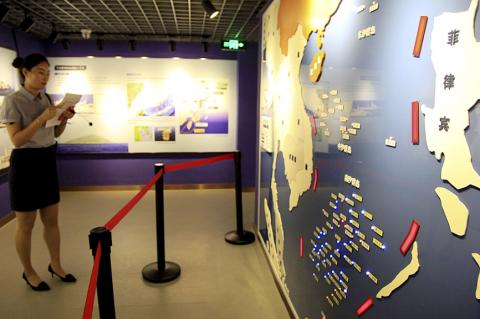President Tsai Ing-wen’s (蔡英文) administration has reached an internal resolution on Taiwan’s territorial claims over the South China Sea, which stresses the nation’s sovereignty over islands in the area, but makes no mention of the so-called “U-shaped line” and “historical waters,” a Presidential Office source said yesterday.
The government wants to differentiate Taiwan’s claims from China’s and avoid the impression that Taipei and Beijing have a unified stance on the issue, said the source, who asked not to be identified.
The U-shaped line — also known as the “11-dash line” — was featured in the “Location Map of the South China Sea Islands” drawn up by the Republic of China (ROC) government in 1947. After the Chinese Nationalist Party (KMT) lost the Chinese Civil War and fled to Taiwan, the Chinese Communist Party changed it to a “nine-dash line.”

Photo: Chinatopix via AP
After the Permanent Court of Arbitration in The Hague, Netherlands, on Tuesday ruled that Beijing’s claims of historical rights over the area based on its nine-dash line were invalid, the Ministry of the Interior and the Mainland Affairs Council issued statements stressing the ROC’s sovereignty over the South China Sea islands.
However, neither statement mentioned the U-shaped line or historical waters, although both referred to the map. That sparked speculation that the government has dropped the U-shaped line claim.
The source said the government’s position is clear: The ROC has sovereignty over South China Sea islands, including Itu Aba Island (Taiping Island, 太平島), and there is no need to mention the U-shaped line or historical waters to assert that position.
Another source said that when the map was drawn in 1947, it only marked the names and locations of the South China Sea islands and 11 demarcation lines, but terms like the “U-shaped line” or “11-dash line” did not exist then.
The demarcation lines were later referred to as the “11-dash line,” and after China proposed the “nine-dash line,” academics created the term U-shaped line to stress the similarity between Taiwan’s and China’s claims.
The term, like the so-called “1992 consensus,” was created and fashioned in retrospect, the source said.
A report by the US Department of State mapped the nine-dash line and 11-dash line and found that they represented different coordinates, suggesting they were different demarcation lines, the source said.
The Presidential Office source questioned the nature of the 11 demarcation lines on the map, saying there are no clear definitions on whether they represent national boundaries, island demarcation lines or historical territorial waters.
Neither the 11-dash line nor the U-shaped line is official terminology or a legal term, the source said.
When asked whether the Tsai administration has made it a policy not to mention the U-shaped line, Presidential Office spokesman Alex Huang (黃重諺) did not give a direct response at a routine news conference yesterday afternoon.
“The ROC government stands firm on its claim of sovereignty over islands in the South China Sea and their relevant waters, which are rightfully our rights in accordance with international law,” Huang said.
Huang said that all relevant documents, including those dating back to 1947, when the ROC government drew the map, show that the official name used is “islands in the South China Sea (南海諸島).”
Additional reporting by Stacy Hsu

The US government has signed defense cooperation agreements with Japan and the Philippines to boost the deterrence capabilities of countries in the first island chain, a report by the National Security Bureau (NSB) showed. The main countries on the first island chain include the two nations and Taiwan. The bureau is to present the report at a meeting of the legislature’s Foreign Affairs and National Defense Committee tomorrow. The US military has deployed Typhon missile systems to Japan’s Yamaguchi Prefecture and Zambales province in the Philippines during their joint military exercises. It has also installed NMESIS anti-ship systems in Japan’s Okinawa

‘WIN-WIN’: The Philippines, and central and eastern European countries are important potential drone cooperation partners, Minister of Foreign Affairs Lin Chia-lung said Minister of Foreign Affairs Lin Chia-lung (林佳龍) in an interview published yesterday confirmed that there are joint ventures between Taiwan and Poland in the drone industry. Lin made the remark in an exclusive interview with the Chinese-language Liberty Times (the Taipei Times’ sister paper). The government-backed Taiwan Excellence Drone International Business Opportunities Alliance and the Polish Chamber of Unmanned Systems on Wednesday last week signed a memorandum of understanding in Poland to develop a “non-China” supply chain for drones and work together on key technologies. Asked if Taiwan prioritized Poland among central and eastern European countries in drone collaboration, Lin

Renewed border fighting between Thailand and Cambodia showed no signs of abating yesterday, leaving hundreds of thousands of displaced people in both countries living in strained conditions as more flooded into temporary shelters. Reporters on the Thai side of the border heard sounds of outgoing, indirect fire yesterday. About 400,000 people have been evacuated from affected areas in Thailand and about 700 schools closed while fighting was ongoing in four border provinces, said Thai Rear Admiral Surasant Kongsiri, a spokesman for the military. Cambodia evacuated more than 127,000 villagers and closed hundreds of schools, the Thai Ministry of Defense said. Thailand’s military announced that

CABINET APPROVAL: People seeking assisted reproduction must be assessed to determine whether they would be adequate parents, the planned changes say Proposed amendments to the Assisted Reproduction Act (人工生殖法) advanced yesterday by the Executive Yuan would grant married lesbian couples and single women access to legal assisted reproductive services. The proposed revisions are “based on the fundamental principle of respecting women’s reproductive autonomy,” Cabinet spokesperson Michelle Lee (李慧芝) quoted Vice Premier Cheng Li-chiun (鄭麗君), who presided over a Cabinet meeting earlier yesterday, as saying at the briefing. The draft amendment would be submitted to the legislature for review. The Ministry of Health and Welfare, which proposed the amendments, said that experts on children’s rights, gender equality, law and medicine attended cross-disciplinary meetings, adding that